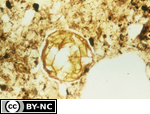Download Image
5.19 MB

ID # 156
Pollen grainFrom the Soil Micromorphology Slide Collection
Appropriate Grade Level(s)
- College-level
- Classroom Lectures
- Laboratory Activities
- Soil Microbiology
Data for 35-mm slide
Micromorphological description of slide: Pollen grain present as an organic body imbedded in the mineral matrix near the soil surface. Pollen grain is approximately 1 75 pm in diameter.
Data for the horizon
Horizon sampled: Ap
Depth sampled: 0-1 5 cm
Physical and chemical data available: pH = 5.9, org. c = 1 .45%, N = 0.14%, exch.Ca = 71 .9%, exch. Mg = 22.2%, exch. K = 2.00%. exch. Na = 0.23%, total exch. cap. (cmol (p 13.0, clay = 1 6%, clay mineralogy = hydrous mica > kaolinite > smectite.
Micromorphological description of horizon: The upper 10 cm of the Ap horizon has separated zones of vughy porphyric (60%) and matrigranoidic (40%) fabrics made up of moderately differentiated and a few discrete and irregular meso and macro granic units. The 10-14 cm depth has a porphyric fabric arrangement. In the upper section voids (50%) are dominantly orthovughs (7/10) of varying size; some macro and mega channels (2/10) and compound packing voids (1110) are also present. In the lower section voids (30%) are made up of meso skew planes (5/1 0), meso and macro channels (3/10), and meso vughs (2/10). Fecal pellets make up 2-5% of the fabric. Strongly welded earthworm fecal pellets occur largely in aggrotubules. Fecal pellets of Diptera (fly) larvae and Collembola (springtails) are found in old root channels. Sporangia and fungal hyphae are common along the root surface.
Macromorphological description of horizon: Ap (0-1 5 cm): Dark grayish brown (IOYR 4/2, m) sandy loam to loam; crumby to massive and fragmented; friable to firm; abrupt smooth boundary.
Data for thin section
Preparation of sample: Air dry
Impregnating medium: Epoxy
Thickness of section: 30 µm
Orientation of section: Vertical
Soil Classification
U.S.: Typic Cryoboralf
F.A.O.: Albic Luvisol
Canada: Orthic Gray Luvisol
Elevation: 700 m above sea level
Topography and hill slope position: Level to undulating upper slope Parent material: Till
Soil climatic data and/or soil water balance: Subhumid moisture regime and cold soil temperature class
Vegetation: Cultivated field of faba beans (Vicia faba)
Micromorphological description of slide: Pollen grain present as an organic body imbedded in the mineral matrix near the soil surface. Pollen grain is approximately 1 75 pm in diameter.
Data for the horizon
Horizon sampled: Ap
Depth sampled: 0-1 5 cm
Physical and chemical data available: pH = 5.9, org. c = 1 .45%, N = 0.14%, exch.Ca = 71 .9%, exch. Mg = 22.2%, exch. K = 2.00%. exch. Na = 0.23%, total exch. cap. (cmol (p 13.0, clay = 1 6%, clay mineralogy = hydrous mica > kaolinite > smectite.
Micromorphological description of horizon: The upper 10 cm of the Ap horizon has separated zones of vughy porphyric (60%) and matrigranoidic (40%) fabrics made up of moderately differentiated and a few discrete and irregular meso and macro granic units. The 10-14 cm depth has a porphyric fabric arrangement. In the upper section voids (50%) are dominantly orthovughs (7/10) of varying size; some macro and mega channels (2/10) and compound packing voids (1110) are also present. In the lower section voids (30%) are made up of meso skew planes (5/1 0), meso and macro channels (3/10), and meso vughs (2/10). Fecal pellets make up 2-5% of the fabric. Strongly welded earthworm fecal pellets occur largely in aggrotubules. Fecal pellets of Diptera (fly) larvae and Collembola (springtails) are found in old root channels. Sporangia and fungal hyphae are common along the root surface.
Macromorphological description of horizon: Ap (0-1 5 cm): Dark grayish brown (IOYR 4/2, m) sandy loam to loam; crumby to massive and fragmented; friable to firm; abrupt smooth boundary.
Data for thin section
Preparation of sample: Air dry
Impregnating medium: Epoxy
Thickness of section: 30 µm
Orientation of section: Vertical
Soil Classification
U.S.: Typic Cryoboralf
F.A.O.: Albic Luvisol
Canada: Orthic Gray Luvisol
Elevation: 700 m above sea level
Topography and hill slope position: Level to undulating upper slope Parent material: Till
Soil climatic data and/or soil water balance: Subhumid moisture regime and cold soil temperature class
Vegetation: Cultivated field of faba beans (Vicia faba)
Method
Frame length: 0.6 mm
Light mode: Plane polarized
Light mode: Plane polarized
References
Pawluk, S. 1 980. Micromorphological investigations of cultivated Gray Luvisols under different management practices. Can. J. Soil Sci. 60:731-745.
Source - S. Pawluk
Source - S. Pawluk
Peer Review: Yes
Credit this item to: SSSAMedia Date: 1993-01-01
Provided By: (SSSA) Soil Science Society of America
Author(s)/Creator(s)
-
* Soil Science Society of America
SSSA
membership@soils.org
Submitted By: (SSSA) Soil Science Society of America
Keywords
- Biological Features
- Ap
- micromorphology
- Pollen grain
Comments
Please login to submit a comment.
Log In to your account
Already a member, certified, or existing customer?*
* Cookies must be accepted to log in.
Not sure if you have an account?
Check Your Email
Join Us!
Connect with members and access the information you need.
Learn more.
Ready to Join?
If you have an account, login on the left. Not sure if you have an account or need to create one? Check your email with the link above. We look forward to welcoming you.